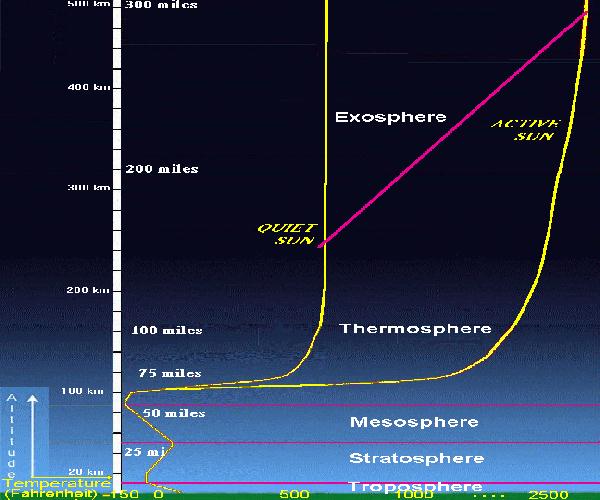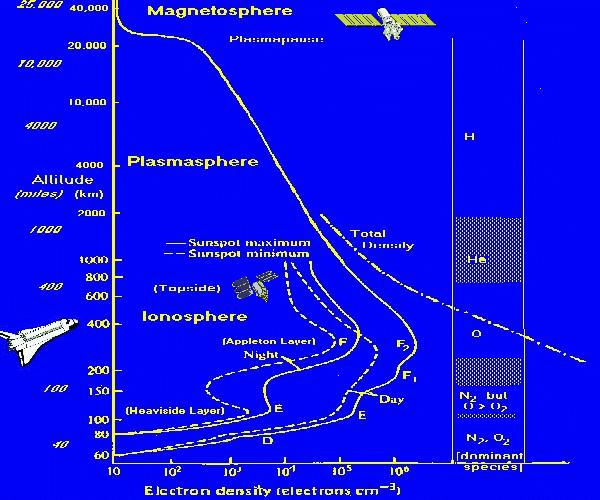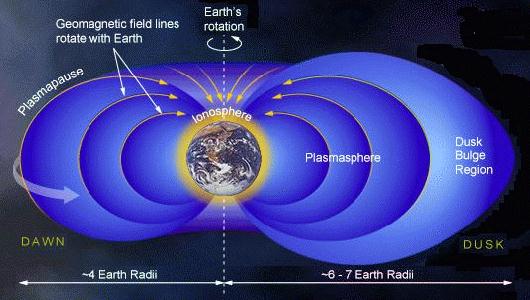what layer of the atmosphere is closest to space
Atmospheric Structure
THERMAL STRUCTURE
Atmospheric layers are characterized past variations in temperature resulting primarily from the absorption of solar radiation; visible light at the surface, nearly ultraviolet radiations in the middle atmosphere, and far ultraviolet radiations in the upper atmosphere. 
Troposphere
The troposphere is the atmospheric layer closest to the planet and contains the largest percentage (around 80%) of the mass of the total atmosphere. Temperature and water vapor content in the troposphere decrease apace with altitude. H2o vapor plays a major role in regulating air temperature because information technology absorbs solar energy and thermal radiations from the planet'south surface. The troposphere contains 99 % of the water vapor in the atmosphere. H2o vapor concentrations vary with breadth. They are greatest in a higher place the tropics, where they may be as high as 3 %, and decrease toward the polar regions.All weather phenomena occur within the troposphere, although turbulence may extend into the lower portion of the stratosphere. Troposphere means "region of mixing" and is and so named because of vigorous convective air currents within the layer.
The upper boundary of the layer, known every bit the tropopause, ranges in height from 5 miles (8 km) virtually the poles upwards to eleven miles (18 km) above the equator. Its height also varies with the seasons; highest in the summer and lowest in the winter.
Stratosphere
The stratosphere is the second major strata of air in the atmosphere. It extends in a higher place the tropopause to an distance of well-nigh 30 miles (fifty km) in a higher place the planet's surface. The air temperature in the stratosphere remains relatively abiding up to an altitude of 15 miles (25 km). Then it increases gradually to upwards to the stratopause. Considering the air temperature in the stratosphere increases with altitude, it does non cause convection and has a stabilizing upshot on atmospheric conditions in the region. Ozone plays the major role in regulating the thermal regime of the stratosphere, as h2o vapor content within the layer is very low. Temperature increases with ozone concentration. Solar energy is converted to kinetic energy when ozone molecules absorb ultraviolet radiation, resulting in heating of the stratosphere.The ozone layer is centered at an altitude between x-15 miles (15-25 km). Approximately ninety % of the ozone in the atmosphere resides in the stratosphere. Ozone concentration in the this region is virtually 10 parts per million by volume (ppmv) every bit compared to approximately 0.04 ppmv in the troposphere. Ozone absorbs the bulk of solar ultraviolet radiation in wavelengths from 290 nm - 320 nm (UV-B radiations). These wavelengths are harmful to life because they can be absorbed by the nucleic acid in cells. Increased penetration of ultraviolet radiations to the planet's surface would damage institute life and have harmful environmental consequences. Appreciably big amounts of solar ultraviolet radiation would result in a host of biological effects, such equally a dramatic increase in cancers.
A popular pastime of late seems to be sending things upwardly on balloons into the stratosphere and posting the video on YouTube
A beer tin can goes to xc,000 anxiety distance (17 miles, 27 km) and lands in the "drinkable"
A toy robot, a Lego Space Shuttle, a Thomas the Train toy, and even an armchair
A man goes to 128,000 feet (24+ miles, 39 km) and jumps breaking the sound barrier as he falls
A balloon is for fine tourists, merely try a rocket to get at that place in a bustle!
Mesosphere
The mesosphere a layer extending from approximately 30 to fifty miles (50 to 85 km) above the surface, is characterized by decreasing temperatures. The coldest temperatures in Earth's atmosphere occur at the top of this layer, the mesopause, especially in the summer near the pole. The mesosphere has sometimes jocularly been referred to as the "ignorosphere" considering information technology had been probably the least studied of the atmospheric layers. The stratosphere and mesosphere together are sometimes referred to every bit the centre atmosphere.Thermosphere
The thermosphere is located above the mesosphere. The temperature in the thermosphere generally increases with distance reaching 600 to 3000 F (600-2000 K) depending on solar action. This increase in temperature is due to the assimilation of intense solar radiation by the limited amount of remaining molecular oxygen. At this extreme altitude gas molecules are widely separated. Above 60 miles (100 km) from Globe's surface the chemical composition of air becomes strongly dependent on altitude and the atmosphere becomes enriched with lighter gases (diminutive oxygen, helium and hydrogen). Also at 60 miles (100 km) altitude, Earth's atmosphere becomes besides sparse to back up aircraft and vehicles demand to travel at orbital velocities to stay aloft. This demarcation betwixt aeronautics and astronautics is known as the Karman Line. Higher up virtually 100 miles (160 km) altitude the major atmospheric component becomes atomic oxygen. At very loftier altitudes, the rest gases begin to stratify co-ordinate to molecular mass, because of gravitational separation.Exosphere
The exosphere is the virtually afar atmospheric region from Globe's surface. In the exosphere, an upward travelling molecule can escape to infinite (if it is moving fast enough) or be pulled dorsum to Globe by gravity (if information technology isn't) with picayune probability of colliding with some other molecule. The altitude of its lower purlieus, known every bit the thermopause or exobase, ranges from well-nigh 150 to 300 miles (250-500 km) depending on solar activity. The upper boundary can be defined theoretically past the altitude (well-nigh 120,000 miles, one-half the distance to the Moon) at which the influence of solar radiation pressure level on atomic hydrogen velocities exceeds that of the Globe's gravitational pull. The exosphere appreciable from space equally the geocorona is seen to extend to at least 60,000 miles from the surface of the Globe. The exosphere is a transitional zone between Earth's atmosphere and interplanetary space.MAGNETO-ELECTRONIC Construction
The upper atmosphere is also divided into regions based on the behavior and number of complimentary electrons and other charged particles. 
Ionosphere
The ionosphere is defined by atmospheric effects on radiowave propagation as a upshot of the presence and variation in concentration of gratis electrons in the atmosphere. D-region is about 35 to 55 miles (sixty - xc km) in altitude but disappears at nighttime.
E-region is about 55 to 90 miles (xc - 140 km) in altitude.
F-region is to a higher place 90 miles (140 km) in atitude. During the day it has two regions known as the Fi-region from most 90 to 115 miles (140 to 180 km) altitude and the F2-region in which the concentration of electrons peaks in the distance range of 150 to 300 miles (around 250 to 500 km). Most recent map of the Height of Maximum (hmF2). The ionosphere above the height electron concentration is usually referred to every bit the Topside Ionosphere.
Plasmasphere

The plasmasphere is not really spherical but a doughnut-shaped region (a torus) with the pigsty aligned with Earth'due south magnetic centrality. [In this case the utilise of the suffix -sphere is more in the figurative sense of a "sphere of influence".] The Earth'due south plasmasphere is made of merely that, a plasma, the fourth state of matter. (Exam your skills on sorting the states of matter with the Thing Sorter.) This plasma is composed mostly of hydrogen ions (protons) and electrons. Information technology has a very sharp edge called the plasmapause. The outer edge of this doughnut over the equator is ordinarily some 4 to 6 World radii from the centre of the World or 12,000-20,000 miles (19,000-32,000 km) to a higher place the surface. The plasmasphere is essentially an extension of the ionosphere. Inside of the plasmapause, geomagnetic field lines rotate with the Globe. The inner edge of the plasmasphere is taken equally the altitude at which protons replace oxygen as the dominant species in the ionospheric plasma which usually occurs at about 600 miles (1000 km) altitude. The plasmasphere can besides be considered to be a structure inside the magnetosphere.
Magnetosphere

Outside the plasmapause, magnetic field lines are unable to corotate because they are influenced strongly past electric fields of solar wind origin. The magnetosphere is a crenel (also not spherical) in which the Globe's magnetic field is constrained by the solar wind and interplanetary magnetic field (IMF). The outer boundary of the magnetosphere is called the magnetopause. The magnetosphere is shaped like an elongated teardrop (like a Christmas Tree ornamentation) with the tail pointing away from the Dominicus. The magnetopause is typically located at nigh ten Earth radii or some 35,000 miles (nearly 56,000 km) above the World'southward surface on the day side and stretches into a long tail, the magnetotail, a few million miles long (about 1000 Earth radii), well past the orbit of the Moon (at around 60 World radii), on the night side of the Earth. However, the Moon itself is commonly not within the magnetosphere except for a couple of days effectually the Full Moon.
Beyond the magnetopause are the magnetosheath and bow shock which are regions in the solar air current disturbed by the presence of Earth and its magnetic field.
Source: https://www.albany.edu/faculty/rgk/atm101/structur.htm
Post a Comment for "what layer of the atmosphere is closest to space"